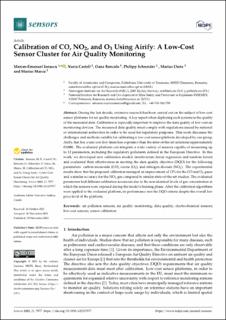| dc.contributor.author | Ionascu, Marian-Emanuel | |
| dc.contributor.author | Castell, Nuria | |
| dc.contributor.author | Boncalo, Oana | |
| dc.contributor.author | Schneider, Philipp | |
| dc.contributor.author | Darie, Marius | |
| dc.contributor.author | Marcu, Marius | |
| dc.date.accessioned | 2021-12-01T07:53:32Z | |
| dc.date.available | 2021-12-01T07:53:32Z | |
| dc.date.created | 2021-11-30T10:07:10Z | |
| dc.date.issued | 2021 | |
| dc.identifier.citation | Sensors. 2021, 00, 7977. | en_US |
| dc.identifier.issn | 1424-8220 | |
| dc.identifier.uri | https://hdl.handle.net/11250/2832234 | |
| dc.description.abstract | During the last decade, extensive research has been carried out on the subject of low-cost sensor platforms for air quality monitoring. A key aspect when deploying such systems is the quality of the measured data. Calibration is especially important to improve the data quality of low-cost air monitoring devices. The measured data quality must comply with regulations issued by national or international authorities in order to be used for regulatory purposes. This work discusses the challenges and methods suitable for calibrating a low-cost sensor platform developed by our group, Airify, that has a unit cost five times less expensive than the state-of-the-art solutions (approximately €1000). The evaluated platform can integrate a wide variety of sensors capable of measuring up to 12 parameters, including the regulatory pollutants defined in the European Directive. In this work, we developed new calibration models (multivariate linear regression and random forest) and evaluated their effectiveness in meeting the data quality objective (DQO) for the following parameters: carbon monoxide (CO), ozone (O3), and nitrogen dioxide (NO2). The experimental results show that the proposed calibration managed an improvement of 12% for the CO and O3 gases and a similar accuracy for the NO2 gas compared to similar state-of-the-art studies. The evaluated parameters had different calibration accuracies due to the non-identical levels of gas concentration at which the sensors were exposed during the model’s training phase. After the calibration algorithms were applied to the evaluated platform, its performance met the DQO criteria despite the overall low price level of the platform. | en_US |
| dc.language.iso | eng | en_US |
| dc.rights | Navngivelse 4.0 Internasjonal | * |
| dc.rights.uri | http://creativecommons.org/licenses/by/4.0/deed.no | * |
| dc.title | Calibration of CO, NO2, and O3 Using Airify: A Low-Cost Sensor Cluster for Air Quality Monitoring | en_US |
| dc.type | Peer reviewed | en_US |
| dc.type | Journal article | en_US |
| dc.description.version | publishedVersion | en_US |
| dc.rights.holder | © 2021 by the authors. Licensee MDPI, Basel, Switzerland. | en_US |
| dc.source.volume | 21 | en_US |
| dc.source.journal | Sensors | en_US |
| dc.identifier.doi | 10.3390/s21237977 | |
| dc.identifier.cristin | 1961421 | |
| dc.relation.project | NILU - Norsk institutt for luftforskning: 120040 | en_US |
| dc.relation.project | EØS - Det europeiske økonomiske samarbeidsområde: 2018/116060 | en_US |
| dc.relation.project | Innovasjon Norge: * | en_US |
| dc.source.articlenumber | 7977 | en_US |
| cristin.ispublished | true | |
| cristin.fulltext | original | |
| cristin.qualitycode | 1 | |

